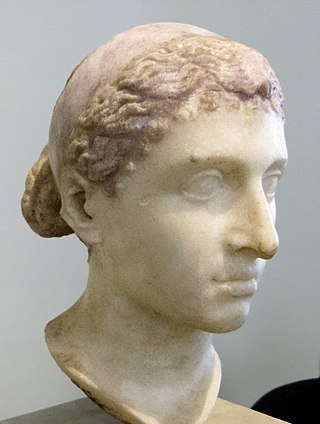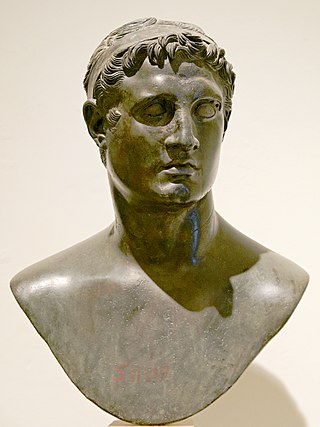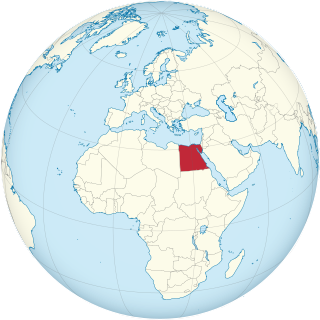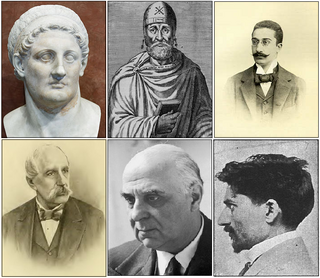
Alexandria is the second largest city in Egypt and the largest city on the Mediterranean coast. Founded in c. 331 BC by Alexander the Great, Alexandria grew rapidly and became a major centre of Hellenic civilization, eventually replacing Memphis, in present-day Greater Cairo, as Egypt's capital. Called the "Bride of the Mediterranean" internationally, Alexandria is a popular tourist destination and an important industrial centre due to its natural gas and oil pipelines from Suez.

Cleopatra VII Thea Philopator was Queen of the Ptolemaic Kingdom of Egypt from 51 to 30 BC, and its last active ruler. A member of the Ptolemaic dynasty, she was a descendant of its founder Ptolemy I Soter, a Macedonian Greek general and companion of Alexander the Great. After the death of Cleopatra, Egypt became a province of the Roman Empire, marking the end of the last Hellenistic-period state in the Mediterranean and of the age that had lasted since the reign of Alexander. Her first language was Koine Greek and she is the only known Ptolemaic ruler to learn the Egyptian language.

Ptolemy III Euergetes was the third pharaoh of the Ptolemaic dynasty in Egypt from 246 to 222 BC. The Ptolemaic Kingdom reached the height of its military and economic power during his kingship, as initiated by his father Ptolemy II Philadelphus.

Egyptology is the scientific study of ancient Egypt. The topics studied include ancient Egyptian history, language, literature, religion, architecture and art from the 5th millennium BC until the end of its native religious practices in the 4th century AD. A practitioner of the discipline is an "Egyptologist".

Ptolemy II Philadelphus was the pharaoh of Ptolemaic Egypt from 284 to 246 BC. He was the son of Ptolemy I, the Macedonian Greek general of Alexander the Great who founded the Ptolemaic Kingdom after the death of Alexander, and Queen Berenice I, originally from Macedon in northern Greece.

The Egyptian Museum in Cairo, commonly known as simply the Egyptian Museum, located in Cairo, Egypt, houses the largest collection of Egyptian antiquities in the world. It houses over 120,000 items, with a representative amount on display. Located in a building built in 1901, it is the largest museum in Africa. Among its masterpieces are Pharaoh Tutankhamun's treasure, including its iconic gold burial mask, widely considered one of the best-known works of art in the world and a prominent symbol of ancient Egypt.

Ptolemy XII Neos Dionysus was a king of the Ptolemaic Kingdom of Egypt who ruled from 80 to 58 BC and then again from 55 BC until his death in 51 BC. He was commonly known as Auletes, referring to his love of playing the flute in Dionysian festivals. A member of the Ptolemaic dynasty, he was a descendant of its founder Ptolemy I, a Macedonian Greek general and companion of Alexander the Great.

Articles related to Egypt include:

The Nile Delta is the delta formed in Lower Egypt where the Nile River spreads out and drains into the Mediterranean Sea. It is one of the world's largest river deltas—from Alexandria in the west to Port Said in the east, it covers 240 km (150 mi) of Mediterranean coastline and is a rich agricultural region. From north to south the delta is approximately 160 km (100 mi) in length. The Delta begins slightly down-river from Cairo.

The Decree of Canopus is a trilingual inscription in three scripts, which dates from the Ptolemaic period of ancient Egypt. It was written in three writing systems: Egyptian hieroglyphs, demotic, and Koine Greek, on several ancient Egyptian memorial stones, or steles. The inscription is a record of a great assembly of priests held at Canopus, Egypt, on 7 Appellaios (Mac.) = 17 Tybi (Eg.) year 9 of Ptolemy III = Thursday 7 March 238 BC. Their decree honoured Pharaoh Ptolemy III Euergetes; Queen Berenice, his wife; and Princess Berenice.

The Grand Egyptian Museum (GEM) Arabic: المتحف المصرى الكبير al-Matḥaf al-Maṣriyy al-Kabīr), also known as the Giza Museum, is an archaeological museum under construction in Giza, Egypt, about 2 kilometres from the Giza pyramid complex. The Museum will host over 100,000 artifacts from ancient Egyptian civilization, including the complete Tutankhamun collection, and many pieces will be displayed for the first time. With 81,000 m2 (872,000 sq ft) of floor space, it is the world's biggest museum. It was built as part of a new master plan for the Giza Plateau, Giza 2030.

The Ptolemaic Kingdom or Ptolemaic Empire was an Ancient Greek state based in Egypt during the Hellenistic period. It was founded in 305 BC by the Macedonian general Ptolemy I Soter, a companion of Alexander the Great, and ruled by the Ptolemaic dynasty until the death of Cleopatra VII in 30 BC. Reigning for nearly three centuries, the Ptolemies were the longest and final dynasty of ancient Egypt heralding a distinctly new era for religious syncretism and the blending of a new Greco-Egyptian culture.

There have been many architectural styles used in Egyptian buildings over the centuries, including Ancient Egyptian architecture, Greco-Roman architecture, Islamic architecture, and modern architecture.

The Graeco-Roman Museum is an archaeological museum located in Alexandria, Egypt.

The Egyptian Greeks, also known as Egyptiotes, or simply Greeks in Egypt, are the ethnic Greek community from Egypt that has existed from the Hellenistic period until the aftermath of the Egyptian coup d'état of 1952, when most were forced to leave.

The Nubian Museum is an archaeological museum located in Aswan, Upper Egypt. It was built following the International Campaign to Save the Monuments of Nubia, to a design by architect Mahmoud El-Hakim for an estimated construction cost of LE 75 million. Dedicated to Nubian culture and civilization, it was inaugurated on November 23, 1997, and was awarded the Aga Khan Award for Architecture in 2001.

The Coptic Museum is a museum in Coptic Cairo, Egypt with the largest collection of Coptic Christian artifacts in the world. It was founded by Marcus Simaika in 1908 to house Coptic antiquities. The museum traces the history of Egypt from its beginnings to the present day. It was erected on 8,000 square meter land offered by the Coptic Orthodox Church, under the guardianship of Pope Cyril V.

The history of Alexandria dates back to the city's founding, by Alexander the Great, in 331 BC. Yet, before that, there were some big port cities just east of Alexandria, at the western edge of what is now Abu Qir Bay. The Canopic (westernmost) branch of the Nile Delta still existed at that time, and was widely used for shipping.

The Children's Civilization and Creativity Center is a children's museum in Heliopolis, Cairo, Egypt, established in 1986. It was renovated twice in 1996 and in 2012. It is a large museum and cultural center covering 4,000 square meters in a 14 Feddan, 14.3 acre landscape. It was built by the Heliopolis Society for the benefit of all the children of Egypt. This work involved contributions from Egyptian and international museums and institutions.

The National Museum of Egyptian Civilization (NMEC) is a large museum located in Old Cairo, a district of Cairo, Egypt. Partially opened in 2017, the museum was officially inaugurated on 3 April 2021 by President Abdel Fattah El-Sisi, with the moving of 22 mummies, including 18 kings and four queens, from the Egyptian Museum in central Cairo, in an event termed the Pharaohs' Golden Parade. The museum displays a collection of 50,000 artifacts, presenting the Egyptian civilization from prehistoric times to the present day.



























